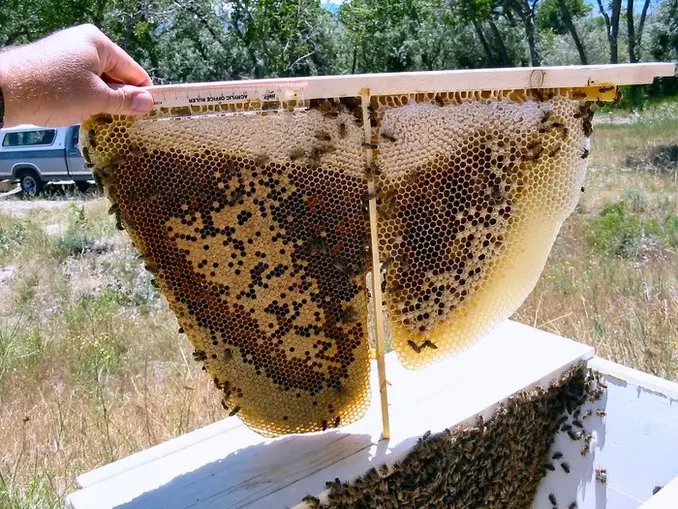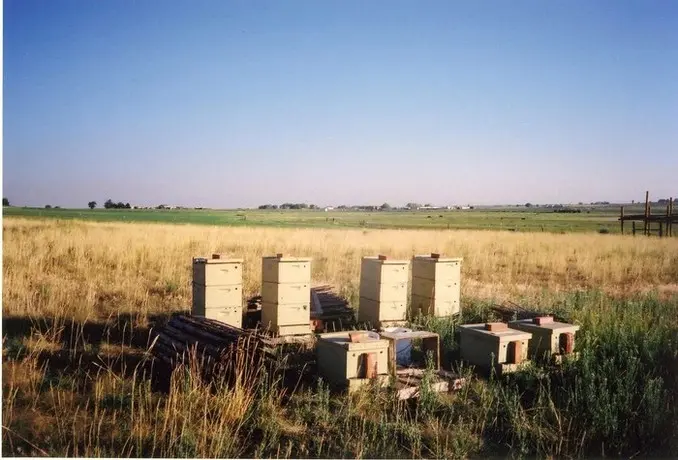Unveiling the Buzz on Small Cell Beekeeping

-Take a peek at the natural cell width size across 10 cells—the foundation of small cell beekeeping.
Let’s Talk Mites
Back in the early ’90s, my hives faced a crisis. Mite vectored viruses and pesticide contamination were wreaking havoc. It was clear that using pesticides to control mites was a futile effort.
Taking a cue from L. Hines and the Lusbys in Arizona, I decided to go for mite-tolerant bees. I set up an untreated, small cell survivor beeyard, and the results were nothing short of phenomenal. After some heavy losses and a fair bit of expensive comb culling, my small cell hives not only survived but thrived without treatments.
The Nitty-Gritty
The first time I spotted varroa mites was in 1993, and by 1996, pesticides were barely making a dent in the mite population. Beekeepers were using various pesticides, treating continuously, and employing more strips per hive, yet many were still losing colonies to mites. Pesticide use came with a hefty price tag:
- Queen rearing became a headache
- Queen quality took a hit
- Supersedure rates went up
- Bees struggled to make it through winter
- Surviving colonies were often small and struggled to thrive
- Beeswax got contaminated
Research was fixated on stronger chemical controls, but the writing was on the wall—pesticides were a dead-end approach.
Mite Tolerant Bees in Arizona
In 1996, Bee Culture magazine showcased Arizona beekeepers who ran pesticide-free operations. L. Hines and the Lusbys were onto something. L. Hines opted for standard field methods and breeding from the feral bee population, while the Lusbys used small cell-sized foundation and bred from local bees.
As a queen producer, I suspected African genetics might be the key to their success, so I gave them a call, hoping to get some stock to test.
L. Hines was intrigued but decided against it due to the risk of unintentionally shipping Africanized honey bees north. Dee Lusby wasn’t selling stock, but she passionately preached about the importance of small cell for over an hour. I barely got a word in.
Something was working in Arizona, but I wasn’t entirely sold on small cell. I didn’t rush to buy a foundation mill, and getting Arizona stock to test proved challenging.
Small Cell—Mite Tolerant, Healthy Bees
It wasn’t until late 1999 that Dadant offered small cell foundation. After regressing 16 colonies and 6 nucs, enduring comb culling and significant hive losses, 12 hives stabilized on small cell comb.

-The bee yard after regressing 16 colonies and 6 nucs.
These small cell colonies:
- Tolerated varroa mites
- Vigilantly removed mite-infected pupa
- Kept the broodnest clean
- Overwintered better
- Built up faster in the spring
- Were overall healthier
During spring and fall, over 95% of the natural mite fall was damaged by the bees. No magnifying lens needed—bite marks and twitching, injured mites were visible on the trays.
Who knew cell size could dramatically influence bee behavior and colony health? The small cell hives prospered without treatments for a solid 8 seasons.
Lusbys Small Cell Theory
Here’s the gist:
- Foundation makers produced worker cells that were too large
- Queen breeders selected for larger bees thriving on larger comb
- Large cell bees were out of balance with their environment
- Large cell bees were inferior to smaller bees found on natural-sized comb
- Large cell bees easily succumbed to additional colony stress
- Pesticides pushed colonies beyond survivable limits
- Returning bees to clean, small cell-sized comb restored colony health and vitality
To get back to small cell:
- Bees are regressed or sequentially stepped back down to smaller cell sizes
- All treatments are abandoned
- Stock is selected from survivors
- Isolated mating yards are required to maintain stock
- Feral bees are sought for their small cell genetics
Interested? Thanks to Barry Birkey at Beesource, there’s a link to the Lusby’s original manuscript.
The Lusbys

-Southern Arizona, home of the Lusbees.
In early 2001, I visited the Lusbys. They:
- Are keen bee observers
- Think for themselves
- Are opinionated
- Love to speculate
- Test their theories in the real world
- Talk nothing but bees day and night
- Didn’t get on the beekeeping fringe by following behind the crowd
In other words, they are fascinating folks to meet if you’re a beekeeper.
I appreciated their warm hospitality. Their insights into bee behavior changed my beekeeping forever. They taught me the most valuable beekeeping principle I’ve ever learned:
Let the bees show you.
So I did.
Experiments
I couldn’t argue with success. Small cell worked. But I had many questions:
- How can an artificially enlarged, inferior bee displace a naturally adapted, superior small cell bee?
- How can putting a bee on a larger cell change its genetic disposition?
- If small cell is so natural, why do bees only draw out so much, then rework the rest into larger sizes?
- And if it’s so natural, why is it so hard to regress bees?
Over the next decade, I did some experimenting and let the bees show me:
- Top bar hives were used to observe natural comb building and bee behavior
- Natural comb from small cell bees, large cell bees, Lusbees, and feral bees was measured
- Relationship between cell bottom patterns and comb orientation in natural comb
- Small cell hives were marked, organized, and monitored using Housel positioning
- Small cell foundation starter strips were compared with natural comb building
- Small cell bees were put on clean, large cell comb and unregressed
- Evaluated Lusby stock with a host of other commercially available stock on small cell comb; no significant differences in mite tolerance were observed
- Recorded seasonal bee size from both large and small cell hives
- Tried using variable-sized foundation to mimic natural comb
- Read historical literature concerning foundation manufacturing and cell size measurements for myself
Results
I expected these experiments and historical research would confirm small cell beekeeping’s concepts. I expected to answer those nagging questions. But like the song says, “Taint necessarily so.”
These observations show that small cell works. But not because bees were artificially enlarged. They weren’t. And not because small-sized bees are more natural than larger ones. They aren’t.
The implications are good news. Most of the onerous small cell regression processes are eliminated, and the benefits are still obtained. It’s possible to move beyond small cell beekeeping to a more natural, much easier way to keep bees.
Small Cell’s Dark Side
Establishing bees on small cell-sized comb produced great results. But it has a big downside—it’s expensive in bees, time, and money. I started with 16 three-deep hives and 6 nucs:
- After the first season, I ended up with 4 dinks and 6 small nucs, losing over 90% of my bees
- Less than 30% of the small cell foundation was acceptably drawn out
- 70% of drawn comb was culled
- Selecting from small cell survivors created a genetic bottleneck with foulbrood-susceptible stock
- It was impossible to set up isolated mating areas or breed out of season in my locale
- It took three years of intensive effort to get a stable, mite-resistant population established in 12 small cell hives
That’s the price paid when working against the bee’s nature. Even when the bees are healthier and tolerate mites.
Small Cell War
Initially, only a few beekeepers were willing to try out small cell beekeeping. These early adopters were experienced beekeepers who openly shared their observations and questions. Initial successes with small cell fueled their enthusiasm, but regression’s downside cast doubt on why small cell worked.
The next generation of adopters were different. Most were novice beekeepers who focused on the enthusiasm and success of the early adopters, often ignoring their small cell problems and failures.
In contrast, small cell naysayers focused on small cell’s problems and failures while completely denying the successes.
Amazingly, both these camps had much in common:
- Little to no actual experience with small cell beekeeping.
- Parroted the rhetoric and even the grammar of their respective camps.
- Indoctrination replaced observation.
- Argument displaced reasoned discussion.
- Defending the high priest became more important than seeking the truth.
- These camps spent more time on the keys than they did with the bees.
Today, mentioning small cell stirs up controversy. And it’s not long before more heat than light is produced.
It’s a great winter sport as each group rallies to defend its sacred cow, especially among the informed and regressed kind. I think it’s how some of them stay warm during the frozen winter months.
But it’s an absolute waste of time as there’s no listening and certainly no learning.
Small Cell’s Lighter Side
My small cell experience forced a re-evaluation of my beekeeping. It was a stepping stone to a better, more natural way to keep bees.
Today, my bees are healthier. They are more productive. And unlike anything related to small cell beekeeping, beekeeping is easier than ever. It’s better to work with the bees than against them. I’m a natural and not a small cell beekeeper now. ✨
-Bee-autifully Yours, D 🐝🤠
